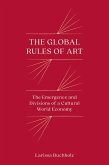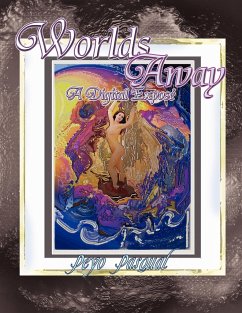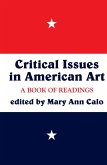Global Art in Local Art Worlds
Changing Hierarchies of Value
Herausgeber: Salemink, Oscar; Sejrup, Jens; Corrêa, Amélia Siegel
Global Art in Local Art Worlds
Changing Hierarchies of Value
Herausgeber: Salemink, Oscar; Sejrup, Jens; Corrêa, Amélia Siegel
- Broschiertes Buch
- Merkliste
- Auf die Merkliste
- Bewerten Bewerten
- Teilen
- Produkt teilen
- Produkterinnerung
- Produkterinnerung
This book explores the attribution and local negotiation of cultural valuations of artistic and art-institutional practices around the world, and considers the diverse ways in which these value attributions intersect with claims of universality and cosmopolitanism.
Andere Kunden interessierten sich auch für
![Toward Forever: Radical Reflections on History and Art Toward Forever: Radical Reflections on History and Art]() Tony MckennaToward Forever: Radical Reflections on History and Art21,99 €
Tony MckennaToward Forever: Radical Reflections on History and Art21,99 €![Star-Art Coloring- Sea Worlds Star-Art Coloring- Sea Worlds]() Jessica TurnerStar-Art Coloring- Sea Worlds15,99 €
Jessica TurnerStar-Art Coloring- Sea Worlds15,99 €![The Global Rules of Art The Global Rules of Art]() Larissa BuchholzThe Global Rules of Art33,99 €
Larissa BuchholzThe Global Rules of Art33,99 €![Twerking to Turking: Everyday Analysis Twerking to Turking: Everyday Analysis]() Eda CollectiveTwerking to Turking: Everyday Analysis19,99 €
Eda CollectiveTwerking to Turking: Everyday Analysis19,99 €![Worlds Away Worlds Away]() Peyo PasqualWorlds Away24,99 €
Peyo PasqualWorlds Away24,99 €![Collecting Activism, Archiving Occupy Wall Street Collecting Activism, Archiving Occupy Wall Street]() Kylie MessageCollecting Activism, Archiving Occupy Wall Street29,99 €
Kylie MessageCollecting Activism, Archiving Occupy Wall Street29,99 €![Critical Issues In American Art Critical Issues In American Art]() Mary Ann CaloCritical Issues In American Art79,99 €
Mary Ann CaloCritical Issues In American Art79,99 €-
-
-
This book explores the attribution and local negotiation of cultural valuations of artistic and art-institutional practices around the world, and considers the diverse ways in which these value attributions intersect with claims of universality and cosmopolitanism.
Produktdetails
- Produktdetails
- Verlag: Taylor & Francis Ltd (Sales)
- Seitenzahl: 304
- Erscheinungstermin: 4. Oktober 2024
- Englisch
- Abmessung: 234mm x 156mm x 17mm
- Gewicht: 449g
- ISBN-13: 9780367653323
- ISBN-10: 036765332X
- Artikelnr.: 71625603
- Herstellerkennzeichnung
- Libri GmbH
- Europaallee 1
- 36244 Bad Hersfeld
- gpsr@libri.de
- Verlag: Taylor & Francis Ltd (Sales)
- Seitenzahl: 304
- Erscheinungstermin: 4. Oktober 2024
- Englisch
- Abmessung: 234mm x 156mm x 17mm
- Gewicht: 449g
- ISBN-13: 9780367653323
- ISBN-10: 036765332X
- Artikelnr.: 71625603
- Herstellerkennzeichnung
- Libri GmbH
- Europaallee 1
- 36244 Bad Hersfeld
- gpsr@libri.de
Oscar Salemink is Professor of Anthropology at the University of Copenhagen, Denmark. Amélia Siegel Corrêa is an independent curator, researcher and a Lecturer in Art History at the Pontificia Universidade Catolica do Parana, Brazil. Jens Sejrup is Assistant Professor of Japanese Studies at the University of Copenhagen, Denmark with a joint appointment in the Departments of Anthropology and Cross-cultural and Regional Studies. Vibe Nielsen is affiliated as postdoctoral researcher at the Pitt Rivers Museum, University of Oxford, UK, where she is a Junior Research Fellow at Linacre College.
Introduction: Global Art in Local Art Worlds and the Global Hierarchy of
Value-Oscar Salemink; Reflection 1: Going Beyond, notes on cultural
valuations and spatial difference-Hou Hanru; Part 1: Tropicalism and
canonization; 1 Inhotim, an international tropical museum: Distinction and
the canonization of Brazilian Avant-Gardes-Amélia Siegel Corrêa;
Reflection 2: The tropics as convention and consecration; Lilia Moritz
Schwarcz; Reflection 3: Is there a Global Cannon? Reflections on World Art
History-Nora A. Taylor; Part 2: recognition and ambivalence; 2 Ambivalent
Art at the Tip of a Continent: the Zeitz MOCAA and its Quest for Global
Recognition-Vibe Nielsen; Reflection 4: Recognition-Michael Rowlands;
Reflection 5: Ambivalence and the racial politics of value-Deborah Posel;
Part 3: Global circulation of ideas and universality; 3 A local universal
modernity: World-Heritagizing Le Corbusier's building for the National
Museum of Western Art in Tokyo-Jens Sejrup; Reflection 6: The role of
public statuary in the global circulation of ideas-Sven Saaler; Reflection
7: Provincializing the universal-Peter Pels; Part 4: Curation and
authorization; 4 Curatorship and authorization in Chinese contemporary art
institutions-Oscar Salemink; Reflection 8: Curation-Pi Li; Reflection 9:
Authorization-Parul Dave Mukherji; Part 5: Validation and circuits of
valuation; 5 From Mumbai to London: Co-constituting value in art from India
via local and global circuits of valuation-Olga Kanzaki Sooudi; Reflection
10: Validation and the global hierarchy of value: moving in a rugged
landscape-João Rickli; Reflection 11: A mandala of value: A granular
approach to art valuation across geopolitical fragments-Manuela Ciotti;
Part 6: Indigenous art and Indigenous cultural capital; 6: Re-collecting,
Re-classifying, Re-ordering: Indigenous Art and the Contemporary Australian
Art Field-Tony Bennett; Reflection 12: Indigenous protagonism and its
impact on the Brazilian art system-Ilana Seltzer Goldstein; Reflection 13:
Indigenous Art: Decolonization through the Looking Glass-Ruth B. Phillips;
Afterword: Agency and Hierarchy in the Creation of Aesthetic Value-Michael
Herzfeld
Value-Oscar Salemink; Reflection 1: Going Beyond, notes on cultural
valuations and spatial difference-Hou Hanru; Part 1: Tropicalism and
canonization; 1 Inhotim, an international tropical museum: Distinction and
the canonization of Brazilian Avant-Gardes-Amélia Siegel Corrêa;
Reflection 2: The tropics as convention and consecration; Lilia Moritz
Schwarcz; Reflection 3: Is there a Global Cannon? Reflections on World Art
History-Nora A. Taylor; Part 2: recognition and ambivalence; 2 Ambivalent
Art at the Tip of a Continent: the Zeitz MOCAA and its Quest for Global
Recognition-Vibe Nielsen; Reflection 4: Recognition-Michael Rowlands;
Reflection 5: Ambivalence and the racial politics of value-Deborah Posel;
Part 3: Global circulation of ideas and universality; 3 A local universal
modernity: World-Heritagizing Le Corbusier's building for the National
Museum of Western Art in Tokyo-Jens Sejrup; Reflection 6: The role of
public statuary in the global circulation of ideas-Sven Saaler; Reflection
7: Provincializing the universal-Peter Pels; Part 4: Curation and
authorization; 4 Curatorship and authorization in Chinese contemporary art
institutions-Oscar Salemink; Reflection 8: Curation-Pi Li; Reflection 9:
Authorization-Parul Dave Mukherji; Part 5: Validation and circuits of
valuation; 5 From Mumbai to London: Co-constituting value in art from India
via local and global circuits of valuation-Olga Kanzaki Sooudi; Reflection
10: Validation and the global hierarchy of value: moving in a rugged
landscape-João Rickli; Reflection 11: A mandala of value: A granular
approach to art valuation across geopolitical fragments-Manuela Ciotti;
Part 6: Indigenous art and Indigenous cultural capital; 6: Re-collecting,
Re-classifying, Re-ordering: Indigenous Art and the Contemporary Australian
Art Field-Tony Bennett; Reflection 12: Indigenous protagonism and its
impact on the Brazilian art system-Ilana Seltzer Goldstein; Reflection 13:
Indigenous Art: Decolonization through the Looking Glass-Ruth B. Phillips;
Afterword: Agency and Hierarchy in the Creation of Aesthetic Value-Michael
Herzfeld
Introduction: Global Art in Local Art Worlds and the Global Hierarchy of
Value-Oscar Salemink; Reflection 1: Going Beyond, notes on cultural
valuations and spatial difference-Hou Hanru; Part 1: Tropicalism and
canonization; 1 Inhotim, an international tropical museum: Distinction and
the canonization of Brazilian Avant-Gardes-Amélia Siegel Corrêa;
Reflection 2: The tropics as convention and consecration; Lilia Moritz
Schwarcz; Reflection 3: Is there a Global Cannon? Reflections on World Art
History-Nora A. Taylor; Part 2: recognition and ambivalence; 2 Ambivalent
Art at the Tip of a Continent: the Zeitz MOCAA and its Quest for Global
Recognition-Vibe Nielsen; Reflection 4: Recognition-Michael Rowlands;
Reflection 5: Ambivalence and the racial politics of value-Deborah Posel;
Part 3: Global circulation of ideas and universality; 3 A local universal
modernity: World-Heritagizing Le Corbusier's building for the National
Museum of Western Art in Tokyo-Jens Sejrup; Reflection 6: The role of
public statuary in the global circulation of ideas-Sven Saaler; Reflection
7: Provincializing the universal-Peter Pels; Part 4: Curation and
authorization; 4 Curatorship and authorization in Chinese contemporary art
institutions-Oscar Salemink; Reflection 8: Curation-Pi Li; Reflection 9:
Authorization-Parul Dave Mukherji; Part 5: Validation and circuits of
valuation; 5 From Mumbai to London: Co-constituting value in art from India
via local and global circuits of valuation-Olga Kanzaki Sooudi; Reflection
10: Validation and the global hierarchy of value: moving in a rugged
landscape-João Rickli; Reflection 11: A mandala of value: A granular
approach to art valuation across geopolitical fragments-Manuela Ciotti;
Part 6: Indigenous art and Indigenous cultural capital; 6: Re-collecting,
Re-classifying, Re-ordering: Indigenous Art and the Contemporary Australian
Art Field-Tony Bennett; Reflection 12: Indigenous protagonism and its
impact on the Brazilian art system-Ilana Seltzer Goldstein; Reflection 13:
Indigenous Art: Decolonization through the Looking Glass-Ruth B. Phillips;
Afterword: Agency and Hierarchy in the Creation of Aesthetic Value-Michael
Herzfeld
Value-Oscar Salemink; Reflection 1: Going Beyond, notes on cultural
valuations and spatial difference-Hou Hanru; Part 1: Tropicalism and
canonization; 1 Inhotim, an international tropical museum: Distinction and
the canonization of Brazilian Avant-Gardes-Amélia Siegel Corrêa;
Reflection 2: The tropics as convention and consecration; Lilia Moritz
Schwarcz; Reflection 3: Is there a Global Cannon? Reflections on World Art
History-Nora A. Taylor; Part 2: recognition and ambivalence; 2 Ambivalent
Art at the Tip of a Continent: the Zeitz MOCAA and its Quest for Global
Recognition-Vibe Nielsen; Reflection 4: Recognition-Michael Rowlands;
Reflection 5: Ambivalence and the racial politics of value-Deborah Posel;
Part 3: Global circulation of ideas and universality; 3 A local universal
modernity: World-Heritagizing Le Corbusier's building for the National
Museum of Western Art in Tokyo-Jens Sejrup; Reflection 6: The role of
public statuary in the global circulation of ideas-Sven Saaler; Reflection
7: Provincializing the universal-Peter Pels; Part 4: Curation and
authorization; 4 Curatorship and authorization in Chinese contemporary art
institutions-Oscar Salemink; Reflection 8: Curation-Pi Li; Reflection 9:
Authorization-Parul Dave Mukherji; Part 5: Validation and circuits of
valuation; 5 From Mumbai to London: Co-constituting value in art from India
via local and global circuits of valuation-Olga Kanzaki Sooudi; Reflection
10: Validation and the global hierarchy of value: moving in a rugged
landscape-João Rickli; Reflection 11: A mandala of value: A granular
approach to art valuation across geopolitical fragments-Manuela Ciotti;
Part 6: Indigenous art and Indigenous cultural capital; 6: Re-collecting,
Re-classifying, Re-ordering: Indigenous Art and the Contemporary Australian
Art Field-Tony Bennett; Reflection 12: Indigenous protagonism and its
impact on the Brazilian art system-Ilana Seltzer Goldstein; Reflection 13:
Indigenous Art: Decolonization through the Looking Glass-Ruth B. Phillips;
Afterword: Agency and Hierarchy in the Creation of Aesthetic Value-Michael
Herzfeld









